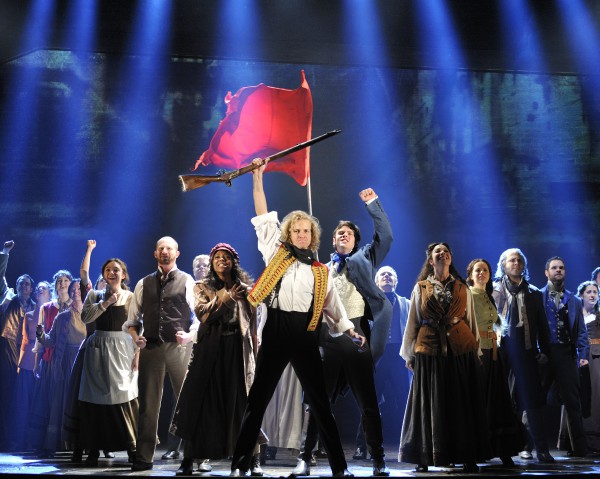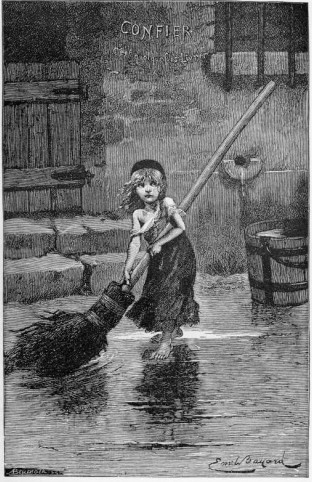Les Miz x 2: On Stage & Screen

Les Miserables Storms the Benedum Center!
The planets have aligned for a rare double feature. The national touring company of Les Miserables is in town at the Benedum Center, through January 27, while the film version is still on local screens. It’s a chance to see how two different directors and casts—working in different media—handle the same material.
I’ve taken my double dose of “Les Miz” and found each version to have its merits. And I’ve enjoyed comparing the two, which then prompted me to compare both to yet another version. Remember the book?
Ah, but first the musical. To recap the plot briefly: Despite what some think, “Les Miz” does not take place in the French Revolution of 1789. That experiment has failed and discontent simmers on throughout France. Our story opens in 1815. The masses, the “miserables” of the title, chafe under the combined burdens of a grossly unequal society and the lack of proper sanitation or care. The film renders the state of affairs vividly, with swaths of dirt-streaked faces, the shrieks and cackles of street mobs, and horrors like the maniacal dentist looking for people who will sell their healthy teeth so that he can pull them for use in dentures. The stage play dwells less on the gruesome particulars, though it’s far from being My Little Pony Tales.
Our hero, Jean Valjean, is a petty criminal just released from a long sentence at hard labor. Rescued from recidivism by a kindly clergyman, he rises to become a man of means and sets out to help others, notably the luckless prostitute Fantine and her daughter Cosette. However, in order to rise, Valjean has broken parole by assuming a new identity. He is pursued in and out of hiding by the relentless Inspector Javert. All paths finally converge around a rebel barricade in the ill-fated Paris revolt of 1832. Many die, but wait! Good, or at least the prospect of good, triumphs in the end.

Famous image of Cosette from the Victor Hugo novel. Illustration by Emile Bayard.
Here is an epic worthy of grand opera, and, in fact, “Les Miz” is more of an opera than a standard musical. On stage and screen alike the actors’ lines are sung, not spoken. And while there is some very nice choreographed movement—as in the stage play, where rhythmic ensemble pieces like the mass-marching of citizens or the heave-ho of galley prisoners can cast a hypnotic spell—this isn’t the kind of musical that wows you with an array of rollicking song-and-dance numbers. One that does stand out is the “Master of the House” bit, which introduces the wicked innkeepers, Monsieur and Madame Thenardier.
The film has Sacha Baron Cohen and Helena Bonham Carter as the tragicomic pair. To my taste they do a fine job, playing their villainous scenes with a sly, intimate connivance well-suited for an up-close medium such as film. Conversely, the stage calls for a bigger brand of nasty in those roles, which the touring company delivers. Timothy Gulan and the wonderful Shawna M. Hamic are brazen cheats, pompous poseurs, not unlike some rather scary public figures of our own time. Their broad humor draws big laughs. Call this comparison a draw.
One way the movie adds value, in some places, is by its ability to move outside the confines of the stage, enacting complex scenes in real-as-life settings. Watch the rebellion scenes. The action begins when a band of student rebels madly try to trigger a mass uprising by hijacking the funeral parade for a general. The film shows much that the play can only suggest, or let happen “offstage.” We see the long, long military cortege marching along a boulevard. A few young men break from the crowd and leap aboard the hearse, only to be forced off to a narrow side street where they throw up a jerry-rigged barricade. The scale of the sequence drives home how futile their tiny endeavor really is.
From here the film’s scale goes tight, also to powerful effect. Soldiers swarm the barricade, firing point-blank at the rebels. Eventually, the student leader Enjolras (played brilliantly in the film by Aaron Tveit) is chased to an upstairs room of a tavern. Several soldiers have him cornered, rifles at the level. Surrender? Nope. In a last small act of defiance, Enjolras coolly raises a hand to display the red banner he’s carrying. Bang bang bang.
In the play mounted at the Benedum, we are behind the rebels’ barricade, viewing all of the action from their perspective. The “soldiers” remain ever unseen on the backstage side; we know they’re out there from the flash-pop stage effects indicating incoming fire, and from rebels crumpling when hit. Yet there is power, too, in this minimalist approach.
For instance, we don’t see the young boy Gavroche being shot. He climbs atop the barricade, then disappears over it on a daring mission to retrieve guns and ammo from fallen soldiers. But we can hear him chanting his taunt to the enemy: “…So never kick a dog just because it’s a pup / You’d better run for cover when the pup grows up.” And when the last word gargles out after a bang, that says it. Little Gavroche won’t be growing up. His silence is more deadly than a movie death.
The play’s finale to the battle at the barricade is stark eloquence. Instead of the film’s detailed tracing of the mop-up and the body count, here we get nothing but a darkly smoking heap of rubble … festooned with dangling, twisted humans … illuminated by fragmented shafts of light. I could say it’s like Picasso’s Guernica or like a surrealist nightmare but that’s a dim approximation.
As for the much happier, hopeful ending of “Les Miz,” I decline to reveal the spoiler. Let’s just say that the stage play’s spare and stately treatment of the closing scene felt more profound than the movie’s panoramic sweep.
But what about the singing, what about the leads? On some counts the film is a clear winner. The central role of Jean Valjean is a demanding one and Hugh Jackman owns it; Anne Hathaway owns Fantine. You can read the nitpicks and the plaudits elsewhere. Or you can read about poor Russell Crowe coming up pitifully small as Javert, to which I’d offer a defense. The script of “Les Miz” (whether for screen or stage) does not give the character of Javert enough room to be fleshed out.
Which, if you care to read more from me, brings us to Victor Hugo’s novel. Granted, no film or play can capture everything in a book it is drawn from. But when “Les Miz” the musical was drawn from the book Les Miserables, vast oceans were left out. Unabridged English editions of the book are around 1400 pages, close to the size of Tolkein’s Lord of the Rings trilogy plus The Hobbit, which spawned FOUR movies that still didn’t get everything.
How much has been lost? One example: By the time Jean Valjean enters the novel—as an ex-convict wandering into a remote town—we’re in the fifteenth chapter. The first 14 chapters tell the life story of the local bishop, who will take in our desperate hero and set him on a new path.
Overkill? Not at all. As every “Les Miz” fan knows, a pivotal point in the saga is the incident of the bishop’s candlesticks. Ex-con Valjean has betrayed his host, stealing away with a sack full of the cleric’s silverware. When the gendarmes catch him and drag him back to the house, the bishop insists that no theft has occurred—the silver was a gift, and oh, look, dear Valjean forgot to take the candlesticks as well! This act of forgiving stirs our hero’s soul. The silver will make him a wealthy man committed to doing good.
In the musical, the incident comes across as a bolt from the blue. Whereas in the book, it’s the stunning payoff to an artful buildup. We have gotten to know this bishop. We have seen him do other remarkable things, sometimes acting on instincts that surprise even himself (as at the end of his visit to a dying atheist, one of many great scenes absent from the musical). Moreover, the bishop’s chapters lay out the great themes that will run through the epic. Such as, that justice without compassion is blind indeed. That bucking “the system” gets complicated, because we have systems living inside our heads; somehow we have put ourselves in chains, and what is the true way to freedom? Good works and loving may be the way, but they’re not easy…
These are the themes that make Les Miserables transcend mere melodrama. They can’t be conveyed fully in a few words. Victor Hugo used all the words he could muster, weaving a massive symphony for the ages.
“Les Miz,” the musical, whether done live or on film, can only strive to hit the keynotes. At times, both versions feel rushed and somewhat empty. There are stretches that skip rapidly from one scene to the next, cramming in the events that must be included to move the story along, while reaching for every shorthand device of stage and screen to fill in the context: the gesture or glimpse that might be worth a thousand words. The blending of music and lyric that rouses intricate emotions quickly.
When these things work, they are magical. Then you come to spots so skimpy that you suspect the director has trimmed footage out of the film, or squeezed stage numbers, with the sole object of keeping the run time down. To love “Les Miz,” you gotta tune in to the magic. Millions have; are you next?
Les Miz plays at the Benedum through January 27, except no performance on Monday Jan. 21. Tickets at trustarts.org.. If your seat is far from the stage try bringing opera glasses, a.k.a. binoculars. They work like magic.
Mike Vargo, an experienced, longtime writer based in Pittsburgh, has himself performed on stage but “not very well,” he says. So he sticks to writing about it.
Photo Credit: Pittsburgh Cultural Trust
Share on Social Media
Follow Entertainment Central
Latest Stories
Sign up for the EC Newsletter







